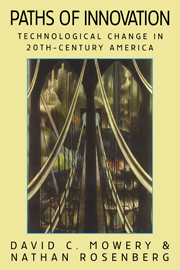7 - Concluding Observations
Published online by Cambridge University Press: 05 June 2012
Summary
Technological change in the 20th-century United States is best understood in the context of a number of favorable and distinctive initial conditions. Among the most important of these was the rich natural-resource base of the U.S. economy. The direction and impact of technological change within this economy were shaped by the fact that the United States was well endowed by nature with the resources that were essential to modern industrialization.
This kindness of Providence to Americans is well known and has often been commented on, but this characterization is seriously incomplete in one sense. Although one may speak of resources as an endowment provided by nature, one must distinguish between natural resources as a geologist would think of them in surveying a new continent and resources in the much stricter sense of the economist. In 1900 oil that was thousands of feet below the sea floor off the coast of Louisiana would not have constituted a resource to the economist, even if the geologist was aware of its presence, simply because the technology required for its extraction did not yet exist.
The point is that natural resources do not intrinsically possess economic value. That value is a function of the availability of technological knowledge that allows those resources to be extracted and subsequently exploited in the fulfillment of human needs (Rosenberg 1972).
- Type
- Chapter
- Information
- Paths of InnovationTechnological Change in 20th-Century America, pp. 167 - 180Publisher: Cambridge University PressPrint publication year: 1998



